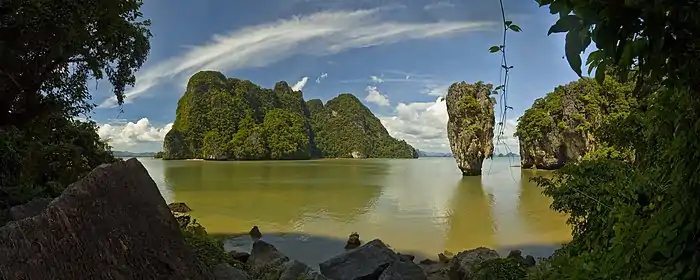Phang Nga province
Phang Nga (Thai: พังงา, pronounced [pʰāŋ.ŋāː]) is one of the southern provinces (Changwat) of Thailand, on the shore of the Andaman Sea to the west and Phang Nga Bay to the south. Neighbouring provinces are (from north, clockwise) Ranong, Surat Thani, and Krabi. To the south is the Phuket province, connected by the Sarasin Bridge.
Phang Nga
พังงา | |
|---|---|
From left to right, top to bottom : Phang Nga Bay, Surin Islands, Similan Islands, Ko Panyi, Khao Lak–Lam Ru National Park | |
 Flag  Seal | |
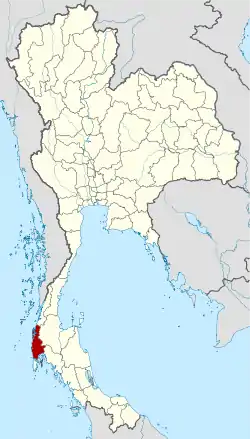 Map of Thailand highlighting Phang Nga province | |
| Country | Thailand |
| Capital | Phang Nga |
| Government | |
| • Governor | Chamroen Thipphayaphongthada (since October 2019)[1] |
| Area | |
| • Total | 4,171 km2 (1,610 sq mi) |
| • Rank | Ranked 53rd |
| Population (2018)[3] | |
| • Total | 268,240 |
| • Rank | Ranked 72nd |
| • Density | 64/km2 (170/sq mi) |
| • Rank | Ranked 68th |
| Human Achievement Index | |
| • HAI (2017) | 0.5649 "somewhat low" Ranked 59th |
| Time zone | UTC+7 (ICT) |
| Postal code | 82xxx |
| Calling code | 076 |
| ISO 3166 code | TH-82 |
| Website | www |
Geography
The province is on the west side of the Malay Peninsula and includes the islands of the Phang Nga Bay. The most famous may be the pair of Khao Phing Kan and Ko Ta Pu, the so-called James Bond Island from the 1974 movie The Man with the Golden Gun, Khao Phing Kan is the home base of the villain, with the needle-shaped limestone rock of Ko Ta Pu, 20 metres (22 yd) off the main beach, featured prominently. Ao Phang Nga (Phang Nga Bay) National Park was established in 1981 to protect the many islands.[5] The Similan Islands and Surin Islands, two of Thailand's main diving destinations, are also part of Phang Nga province.[6] The total forest area is 1,778 km2 (686 sq mi) or 32.4 percent of provincial area.[7]
Toponymy
Phang Nga is the modern Thai transliteration of the archaic Malay word Pangan, literally 'jungle'. The phrase orang Pangan denotes 'heathen, pagan, primitive people', about a generalized tribe or people typically inhabiting jungle areas of the Malay Peninsula[8] and its offshore islands.
History
Historically, during the reign of King Rama II, nearby areas (including Thalang, now known as Phuket) were occupied by the Burmese and so many people fled to Kraphu Nga. In 1824 when Siamese troops defeated the Burmese and were expelled, King Rama III renamed the area adjacent to the bay phang-nga. This bastardization of Malay pangan offers indicates that the entire region may have been populated by Orang Asli or other aboriginal peoples. In 1933 the town was promoted to provincial status.
On the morning of 26 December 2004, the Andaman Sea coastline of the province was devastated by a tsunami and thousands lost their lives.
The Khura Buri District, particularly Ko Phra Thong, has been called a "smuggler's paradise" and thus a key entry point into Thailand for human trafficking, Rohingya, Uighur, and Syrian refugees particularly.[9]
Symbols

The provincial seal shows the Phu Khao Chang mountains in the background with the city hall in front. It also shows a dredge to represent the tin mining in the province.[10]
The provincial slogan is, "Massive mining industry, Ban Klang Nam 'floating house', delightful caves, strangely shaped hills, Jampun flower, rich in resources".[10]
The provincial tree is Cinnamomum porrectum (hardy cinnamon), and the provincial flower is Anaxagorea javanica.
Administrative divisions
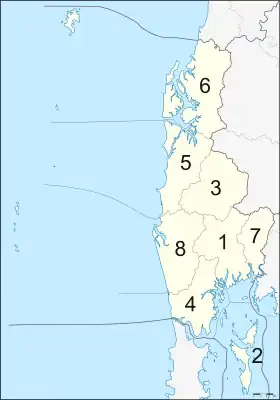
Provincial government
Phang Nga is divided into eight districts (amphoes), which are further divided into 48 subdistricts (tambons) and 314 villages (mubans).
|
Local government
As of 26 November 2019, there are:[11] one Phang Nga Provincial Administration Organisation (ongkan borihan suan changwat) and 15 municipal (thesaban) areas in the province. Phang Nga and Takua Pa have town (thesaban mueang) status. Further 13 subdistrict municipalities (thesaban tambon). The non-municipal areas are administered by 36 Subdistrict Administrative Organisations - SAO (ongkan borihan suan tambon).[3]
Transportation
- Roads: Hwy 4 is the main route that connects all districts in Phang Nga (except Kapong and Ko Yao). Hwy 401 connects Phang Nga to Surat Thani. Hwy 402 connects Phang Nga to Phuket province. Hwy 4090 connects Muang to Kapong District.
- Railways: There is no rail system in Phang Nga province. The nearest railway station is at Phunphin district, Surat Thani province.
- Bus: There are frequent buses to Bangkok and other provinces. There are also non-air conditioned intra-provincial buses.
- Public transit: Songthaews are the most popular mode of public transportation in Phang Nga.
- Motorbike-taxi: These are found mainly in Phang Nga town and are used mainly for very short distances. Charges corresponding to the distance traveled.
- Airport: There is currently no airport in Phang Nga province. The nearest airport is Phuket International Airport. A future Phang Nga airport is proposed for the province, which will serve three provinces — Phang Nga, Krabi, and an alternative for the existing airport at Phuket.[12][13]
Human achievement index 2017
| Health | Education | Employment | Income |
| 9 | 51 | 76 | 20 |
| Housing | Family | Transport | Participation |
 |
 |
 |
|
| 70 | 34 | 18 | 26 |
| Province Phang Nga, with an HAI 2017 value of 0.5649 is "somewhat low", and occupies place 59 in the ranking. | |||
Since 2003, United Nations Development Programme (UNDP) in Thailand has tracked progress on human development at the sub-national level using the Human achievement index (HAI), a composite index covering all the eight key areas of human development. The National Economic and Social Development Board (NESDB) has taken over this task since 2017.[4]
| Rank | Classification |
| 1 - 15 | "high" |
| 16 - 30 | "somewhat high" |
| 31 - 45 | "average" |
| 45 - 60 | "somewhat low" |
| 61 - 77 | "low" |
| Map with provinces and HAI 2017 rankings |
 |
National parks
There are six national parks, along with fourteen other national parks, makeup region 5 (Nakhon Si Thammarat) of Thailand's protected areas. These national parks are diverse and surrounded by nature's gifts.
- Ao Phang Nga (Phang Nga Bay) National Park (อุทยานแห่งชาติอ่าวพังงา) was declared a national park on 29 April 1981. The parks area is 250,000 rai ~ 400 square kilometers (150 sq mi)[14]: 25 It has scenic views and features mass limestone formations scattered around in the sea near the shore. The same factors contribute to the density of caves in the area. The park is fertile with mangroves and there are several islands in the vicinity.
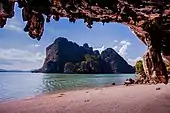 Phang-nga National Park
Phang-nga National Park Limestone islets in Phang-nga National Park
Limestone islets in Phang-nga National Park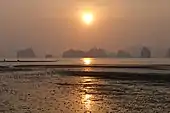 Sunset in Phang Nga Bay
Sunset in Phang Nga Bay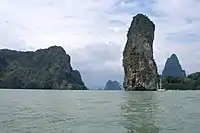 Karst formations
Karst formations
- Mu Ko Surin National Park (อุทยานแห่งชาติหมู่เกาะสุรินทร์) is an archipelago of five islands: Ko Surin Nuea, Ko Surin Tai, Ko Ri, Ko Khai, and Ko Klang. It was declared a national park on 9 July 1981.[15] The national parks area is 88,282 rai ~ 141 square kilometers (54 sq mi).[14]: 30 The archipelago is in the Andaman Sea, near the Thai-Burmese oceanic border.
- Si Phang Nga National Park (อุทยานแห่งชาติศรีพังงา) was declared a national park on 16 April 1988. The park occupies an area of 153,800 rai ~ 246 square kilometers (95 sq mi).[14]: 56 The landscape of the park is dominated by rugged mountains covered with dipterocarp forests.
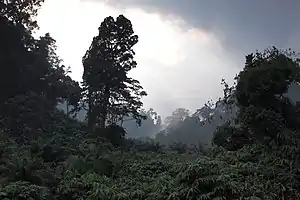
- Khao Lak–Lam Ru National Park (อุทยานแห่งชาติเขาหลัก-ลำรู่) was declared a national park on 30 August 1991. The park occupies an area of 78,125 rai ~ 125 square kilometers (48 sq mi)[14]: 66 and covers Thai Mueang District, Kapong District, Takua Pa District, and Mueang District. The interesting attractions are: Khao Lak (เขาหลัก), which has the Chao Pho Khao Lak Shrine, Laem Pakarang (แหลมปะการัง) which has groves of pine, making it good for camping and relaxation, and Namtok Ton Chong Fa (น้ำตกโตนช่องฟ้า) or Ton Chong Fa Waterfall.[16]
- Khao Lampi–Hat Thai Mueang National Park (อุทยานแห่งชาติเขาลำปี-หาดท้ายเหมือง) The park occupies an area of 44,950 rai ~ 72 square kilometers (28 sq mi).[14]: 52 It was declared a national park on 14 April 1988. Interesting attractions in the park include: Namtok Lampi (น้ำตกลำปี) is a 6-tiered waterfall that runs all year round; Namtok Ton Phrai (น้ำตกโตนไพร), a huge waterfall that runs all year round; and Hat Thai Mueang (หาดท้ายเหมือง), a long beach where the Sea Turtle Festival is held annually.[17]
- Mu Ko Similan National Park (อุทยานแห่งชาติหมู่เกาะสิมิลัน) was declared a national park on 1 September 1982. The park occupies an area of 87,500 rai ~ 140 square kilometers (54 sq mi)[14]: 43 Similan is a group of nine islands. Off-season is 16 May–31 October.[18]
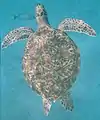 Turtle at Similan
Turtle at Similan Whale shark at Similan
Whale shark at Similan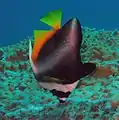 Phantom Bannerfish at Similan
Phantom Bannerfish at Similan
Wildlife sanctuary
There is one wildlife sanctuary, along with three other wildlife sanctuaries, makeup region 5 (Nakhon Si Thammarat) of Thailand's protected areas.
- Namtok Song Phraek Wildlife Sanctuary occupies an area of 138,712 rai ~ 222 square kilometers (86 sq mi).[19]: 8 The wildlife sanctuary was previously known as Ton Pariwat wildlife sanctuary and covers Kapong district, Mueang Phang Nga district, and Thap Put district.
Gallery
 Dusty road around Phang Nga town
Dusty road around Phang Nga town Northern entrance to Phang Nga Bay
Northern entrance to Phang Nga Bay Mu Ko Similan National Park
Mu Ko Similan National Park Limestone islets in Phangnga Bay
Limestone islets in Phangnga Bay Limestone islets in Phangnga Bay, Ao Phangnga National Park
Limestone islets in Phangnga Bay, Ao Phangnga National Park Emerald lagoon in Phang Nga Bay
Emerald lagoon in Phang Nga Bay Cardisoma carnifex at Similan Islands
Cardisoma carnifex at Similan Islands
 Khao Lampi–Hat Thai Mueang National Park
Khao Lampi–Hat Thai Mueang National Park View from Similan Island to Andaman Sea
View from Similan Island to Andaman Sea Mai-Ngam beach, Surin Islands National Park
Mai-Ngam beach, Surin Islands National Park Khao Lak–Lam Ru National Park
Khao Lak–Lam Ru National Park
References
- "ประกาศสำนักนายกรัฐมนตรี เรื่อง แต่งตั้งข้าราชการพลเรือนสามัญ" [Announcement of the Prime Minister's Office regarding the appointment of civil servants] (PDF). Royal Thai Government Gazette. 136 (Special 242 Ngor). 15. 28 September 2019. Archived from the original (PDF) on 29 September 2019. Retrieved 24 November 2019.
- Advancing Human Development through the ASEAN Community, Thailand Human Development Report 2014, table 0:Basic Data (PDF) (Report). United Nations Development Programme (UNDP) Thailand. pp. 134–135. ISBN 978-974-680-368-7. Archived from the original (PDF) on 1 August 2019. Retrieved 17 January 2016, Data has been supplied by Land Development Department, Ministry of Agriculture and Cooperatives, at Wayback Machine.
{{cite report}}: CS1 maint: postscript (link) - "รายงานสถิติจำนวนประชากรและบ้านประจำปี พ.ศ.2561" [Statistics, population and house statistics for the year 2018]. Registration Office Department of the Interior, Ministry of the Interior (in Thai). 31 December 2018. Archived from the original on 14 June 2019. Retrieved 20 June 2019.
- Human achievement index 2017 by National Economic and Social Development Board (NESDB), pages 1-40, maps 1-9, retrieved 14 September 2019, ISBN 978-974-9769-33-1
- "Ao Phang-nga National Park". Department of National Parks (DNP) Thailand. Archived from the original on 20 October 2014. Retrieved 26 May 2015.
- "About Phang Nga". Tourism Authority of Thailand (TAT). Archived from the original on 22 April 2019. Retrieved 16 December 2018.
- "ตารางที่ 2 พี้นที่ป่าไม้ แยกรายจังหวัด พ.ศ.2562" [Table 2 Forest area Separate province year 2019]. Royal Forest Department (in Thai). 2019. Archived from the original on 10 April 2021. Retrieved 6 April 2021, information, Forest statistics Year 2019
{{cite web}}: CS1 maint: postscript (link) - Mid 19th century; earliest use found in Thomas Newbold (1807–1850), an army officer in the East India Company and oriental scholar. Malay: Pangan, a tract of forest (Oxford Dictionaries).
- Yongcharoenchai, Chaiyot; Na Thalang, Jeerawat (20 September 2015). "Tied up in a trafficking jam". Bangkok Post. Archived from the original on 1 May 2023. Retrieved 20 September 2015.
- "Symbol of Phang Nga". OSM Andamnan: The Office of Strategy Management for Southern Province Cluster. Archived from the original on 26 May 2015. Retrieved 26 May 2015.
- "Number of local government organizations by province". dla.go.th. Department of Local Administration (DLA). 26 November 2019. Archived from the original on 26 November 2019. Retrieved 10 December 2019.
33 Phang Nga: 1 PAO, 2 Town mun., 13 Subdistrict mun., 36 SAO.
- "Phang Nga - Andaman International Airport New Airport Profile | CAPA". centreforaviation.com. Archived from the original on 8 December 2022. Retrieved 8 December 2022.
- "» New airport planned for Phangnga to serve southern tourism". thaiembdc.org. Archived from the original on 8 December 2022. Retrieved 8 December 2022.
- . "ข้อมูลพื้นที่อุทยานแห่งชาติ ที่ประกาศในราชกิจจานุบกษา 133 แห่ง" [National Park Area Information published in the 133 Government Gazettes]. Department of National Parks, Wildlife and Plant Conservation (in Thai). December 2020. Archived from the original on 3 November 2022. Retrieved 1 November 2022.
- "Mu Ko Surin National Park". Department of National Parks (DNP) Thailand. Archived from the original on 26 May 2015. Retrieved 26 May 2015.
- "Khao Lak-Lam Ru National Park". Department of National Parks (DNP) Thailand. Archived from the original on 20 April 2013. Retrieved 26 May 2015.
- "Khao Lampi–Hat Thai Mueang National Park". Department of National Parks (DNP) Thailand. Archived from the original on 26 May 2015. Retrieved 26 May 2015.
- "Mu Koh Similan National Park". Tourism Authority of Thailand (TAT). Archived from the original on 26 May 2015. Retrieved 26 May 2015.
- "ตาราง 5 พื้นที่เขตรักษาพันธุ์สัตว์ป่า พ.ศ. 2562" [Table 5 Wildlife Sanctuary Areas in 2019] (PDF). Department of National Parks, Wildlife Sanctuaries and Plant Conservation (in Thai). 2019. Archived (PDF) from the original on 16 November 2022. Retrieved 1 November 2022.
External links
 Phang Nga travel guide from Wikivoyage
Phang Nga travel guide from Wikivoyage- Provincial website
